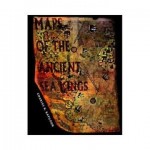What Do Ancient World Maps Tell Us?

Published By: Souvenir Press
London
“In 1492, Columbus sailed the ocean blue.” This was a little jingle my teacher taught the class when we were studying American history to help us remember an important date. We were told that this was the year when seaworthy ships first began to cross the Atlantic Ocean and explore new worlds. It was assumed that accurate surveying and mapping methods were not used by earlier civilizations. Another assumption found in most history texts is that the earliest humans were ape-like cavemen who gradually, over hundreds of thousands of years, learned to talk, develop tools, build houses and ships, and become civilized.
In 1492, some of the known regions of Europe and Northern Africa were not well surveyed, and maps of these areas were often inaccurate. When accurate maps of yet undiscovered parts of the world began to show up, these assumptions were challenged. So, how did Turkish admirals and other come to possess maps of places all over the world that were drawn during the 1300s AD through the 1500s AD and later?
The Turkish Admiral Peri Reis drew one of the most amazing maps, showing the shorelines of the eastern coast of South American, western Africa, and the Atlantic shorelines of Antarctica. The distance and location of Africa across the Atlantic to South America showed a high level of accuracy. His map included the Amazon River, years before it was officially “discovered.” Antartica was also included on his map, although it was drawn farther north than it should have been.
Oronteus Finneus possessed a map compiled in 1513 AD that even showed Antarctica before icepacks had fully built up. Mountain ranges, river valleys, and bays were visible.
Turk Hadji Ahmed’s map drawn in 1559 showed a strip of land 1000 miles wide connecting Siberia and Alaska where the Bering Strait is now.
Turk Ibn Ben Zara’s map was drawn in 1487 AD and showed Europe and North Africa, but with more islands visible than there are today in the Mediterrean, Adriactic and Agean Seas. This would fit with the idea that ocean levels were lower when the original maps were drawn than they are today because of the Ice Age.
Maps drawn by famous mapmakers Buache and Mercator chartered locations and shorelines of Antarctic during the 1700s, well before the Russian expedition in 1818 AD officially discovered this landmass. Chinese mapmakers also produced accurate maps of surrounding areas hundreds of years earlier.
This is such a puzzle that some people find the only logical answer to be space aliens that shared their advanced technology with us at some time in the past. Some scientists assign these findings to the category of “interesting mysteries” and just leave them there. However, there is a more logical explanation that needs to be considered, one that agrees with the Biblical account of a worldwide flood. The next post will take a look at this possibility.
Copies of these and other ancient maps have been compiled by Charles Hapgood in his book Maps of the Ancient Sea Kings. (Copies can be found on Amazon and through other book sellers.)